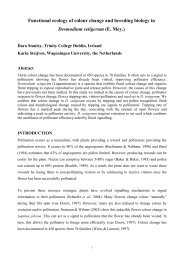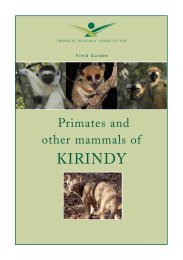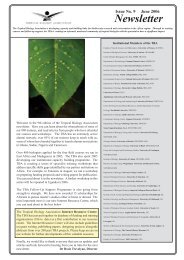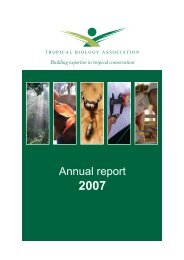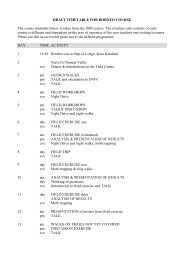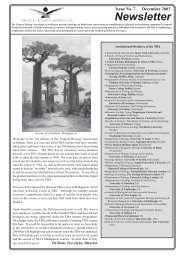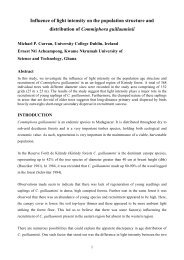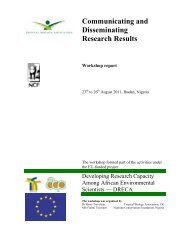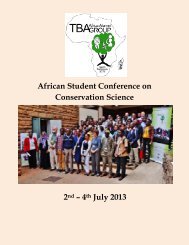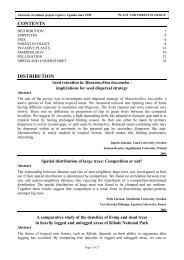Download TAAG Book of Abstracts - Tropical Biology Association
Download TAAG Book of Abstracts - Tropical Biology Association
Download TAAG Book of Abstracts - Tropical Biology Association
Create successful ePaper yourself
Turn your PDF publications into a flip-book with our unique Google optimized e-Paper software.
Conservation and Threats <strong>of</strong> the Dinder National Park,<br />
Sudan<br />
Razan Nimir<br />
University <strong>of</strong> Khartoum, Sudan<br />
Email for correspondence: razannimir@gmail.com<br />
Abstract<br />
The Dinder National Park (1024 km 2 ) in the Southeastern<br />
Sudan is a Ramsar Site, biosphere reserve and<br />
archeological sites. It is home to 27 big mammal species,<br />
250 bird species (it falls in the flyway migratory species),<br />
32 fish species and over 58 trees and shrub species, in<br />
addition to other less documented wildlife species. The<br />
IUCN has listed a number <strong>of</strong> species from the DNP in its<br />
red list <strong>of</strong> threatened species such as the African lion,<br />
Greater kudu, Tiang, Wild dog, African elephant, Redfronted<br />
gazelle, Greater spotted eagle, Pangolin and<br />
Aardvark. The park has recently experienced some<br />
levels <strong>of</strong> deterioration as a result <strong>of</strong> poaching, illegal<br />
livestock, grazing, fire, human settlement around the<br />
park, illegal wood collection, honey collection and<br />
fishing. A global environmental fund (GEF) project in<br />
2000-2004 developed a management plan for the DNP<br />
based on the concept <strong>of</strong> biosphere reserve. European<br />
Union (EU) fund updated the park and produced<br />
budgeted plan for 2011-2015. This study is ongoing and<br />
will discuss and targeted at efforts toward implement<br />
the EU plan.<br />
Keywords: Dinder, species, endangered, threat,<br />
biosphere.<br />
Fragmentation <strong>of</strong> the Eastern Mau Forest and its<br />
Effects on Avifauna’s Composition and Diversity<br />
1 *Faith Milkah W. Muniale, 2 Wegulo, F. and 2 Shivoga,<br />
W.A.<br />
1 ERMIS Africa P.O. Box 17347-20100 Nakuru<br />
2 Faculty <strong>of</strong> Environment and Development, Egerton<br />
University, P.O. Box 536 -20170 Njoro<br />
*Email for correspondence: fngugi2001@gmail.com<br />
Abstract<br />
Eastern Mau forest is under threat from increasing<br />
human activities that led to rapid changes in land cover<br />
and deterioration <strong>of</strong> environmental condition.<br />
Degrading activities include replacement <strong>of</strong> indigenous<br />
tree species with exotic ones, clearing riparian<br />
vegetation, deforestation and forest fragmentation.<br />
Eastern escarpment <strong>of</strong> Mau is extensively degraded and<br />
fragmented. Forest area progressively declined from<br />
47% in 1970 to 15% in 1998. Between 1986 and 2005,<br />
the forest lost 10% and 9% <strong>of</strong> indigenous and plantation<br />
forests, respectively. The investigation was done on the<br />
effects <strong>of</strong> habitat fragmentation on birds focusing on<br />
composition, abundance and diversity in 3 forest<br />
fragments in Eastern Mau. Main data collection method<br />
was mist netting. Length <strong>of</strong> sampling time per station<br />
depended on rate <strong>of</strong> capture. Statistical and descriptive<br />
analyses were performed using MINITAB (version 13.1).<br />
Analysis <strong>of</strong> variance (ANOVA) for Diversity Indices <strong>of</strong> the<br />
different forest fragments was done at 95% significance<br />
level. A total <strong>of</strong> 238 individual birds from 49 different<br />
species, 17 Families and 4 Orders were mist netted and<br />
ringed. The larger forest fragments recorded highest<br />
number <strong>of</strong> species and highest number <strong>of</strong> birds<br />
compared to smaller fragments. About 39% <strong>of</strong> captured<br />
birds were forest bird species. Only 7% <strong>of</strong> captured birds<br />
were juveniles. This study concludes that forest<br />
fragmentation has affected the distribution, diversity<br />
and abundance <strong>of</strong> birds in Eastern Mau forest. The study<br />
recommends reforestation program to bridge gaps<br />
between fragments, stop opening up forest land for<br />
cultivation and enhance community participation in<br />
conservation <strong>of</strong> Eastern Mau Forest.<br />
Keywords: Forest fragmentation, Birds, Diversity,<br />
Eastern Mau Forest<br />
<strong>TAAG</strong> First African Student’s Conference, Nairobi. 2-4 July, 2013 29




